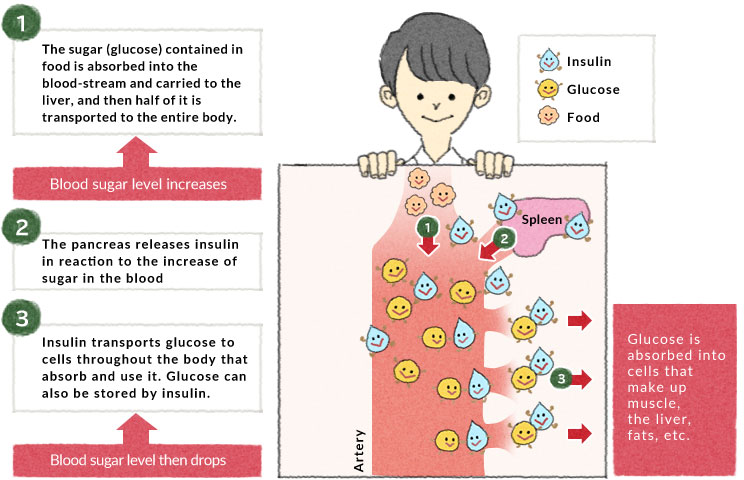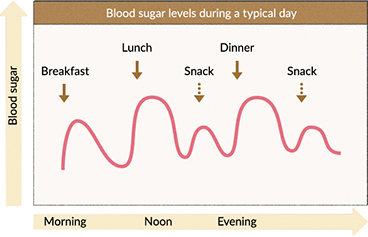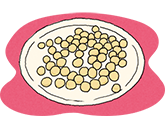The relationship between blood sugar level and GI
The blood sugar level regulation mechanism
When you eat rice, bread, or any other typical food high in carbohydrates, it is digested by the stomach and small intestine, where it is absorbed into the blood as glucose. Figure 1 shows how it is absorbed into the body.

- 1The sugar in food is absorbed into the blood as glucose.
- 2The pancreas secretes insulin in reaction to the increase in glucose.
- 3Because the glucose is absorbed into the liver, muscle, adipose (fat) tissue and other cells, the blood sugar level drops to the level it was before anything was eaten.
This is the mechanism found in healthy people.
When glucose enters the bloodstream, insulin facilitates its uptake into the body's cells. When an excess of glucose is ingested, insulin over secretion occurs. Insulin increases the biosynthesis of fat and suppresses its breakdown. Thus, it becomes easier for fat to accumulate in body tissues.
Blood sugar level will not drop if the sugar in the blood is not properly processed due to, for example, too little insulin being secreted, or resistance to the action of insulin. If blood sugar levels have not decreased several hours after eating on a regular basis, this indicates a susceptibility to diabetes. To avoid this and stay healthy, we should eat types of foods that will not cause a sudden, extreme rise in blood sugar levels.
What is BMI?
| BMI = weight (kg) ÷height (m)2 | BMI is a measure of body fat based on your weight in relation to your height. BMI less than 18.5 = low body weight, BMI 18.5 to 25 = ordinary body weight, BMI 25 or more = obese. |
|---|
What is a healthy blood sugar level
- Fasting blood sugar level 99mg/dL (Japan Society of Ningen Dock)
- Postprandial blood sugar level (2 hours after eating) 7.8mmol/L (140mg/dL) (International Diabetes Federation)
Blood sugar level rises every time you eat

Your blood sugar level rises immediately after eating a meal or snack (Figure 2). In a healthy person, insulin then starts working, and the blood sugar level returns to the pre-meal level 2 hours after eating.
In untreated diabetes patients, the blood sugar level does not return to the pre-meal level of its own accord. Some people's blood sugar level remains high two hours after eating, even though on an empty stomach it would be at a normal level. As a result, the risk of developing diabetes increases as insulin is not properly secreted, or does not work properly in the body.
In order to make sure insulin works properly, it is important not to overeat and to avoid becoming obese. Knowing which foods will not cause a sudden and extreme spike in blood sugar level and using this knowledge in your daily life will help you to prevent obesity and diabetes, and maintain good health.
What foods do not raise blood sugar level much?
High calorie foods may or may not cause the blood sugar level to rise
Many people think that all high-calorie foods raise blood sugar level, but this is not always the case.
In general, foods that cause blood sugar level to rise the most are those that are high in carbohydrates, which are quickly converted into energy, such as rice, bread, fruits and sugar.
Next are foods high in protein, such as meats, fish eggs, milk and dairy products, and oily foods.
However, even though carbohydrates affect blood sugar levels, if you don't eat them your diet will be unbalanced and you won't feel satisfied after your meal, which can lead to excessive consumption of foods rich in protein and fat.
Food containing three major nutrients
| Carbohydrates (Sugars and dietary fiber) |
Rice, bread, noodles, potatoes, beans, vegetables, mushrooms, seaweeds, fruits, sugar etc. |
|---|---|
| Protein | Meats, fish and shellfish, eggs, soybeans and soy products, milk and dairy products etc. |
| Fat | Oil and fats |
Carbohydrates do raise blood sugar levels quickly. However, recent studies have shown that even amongst foods that have the same amount of carbohydrates, there are two categories: those that cause a sudden rise in blood sugar levels and those that cause a more moderate rise, depending on the amount of dietary fiber contained.
Taking bread as an example, whole grain rye bread and pizza crusts are low GI foods, while French bread and bagels are high GI foods.
It is important to know which foods are low GI and which are high GI.
The University of Sydney has defined foods with a GI value of over 70 as "high GI foods," foods with a GI value of between 56 and 69 as "mid-range GI foods," and foods with a GI value of 55 or under as "low GI foods", when using glucose as the reference food (where glucose = 100).
Because high GI foods cause a sudden spike in the blood sugar level, large amounts of insulin are secreted in order to process the sugar in the blood, causing a spike in insulin secretion to handle the sugar. When low GI foods are eaten, the sugar is gradually absorbed into the body so the blood sugar level rises gradually. Thus, an appropriate amount of insulin is secreted and sugar is promptly taken up by the tissues.
Thus, knowing which foods are low GI foods (causing moderate amounts of sugar to be absorbed) is very important to living a healthy life.
Making sure that carbohydrates, an essential type of nutrient, are absorbed by the body in moderate amounts is related to blood sugar levels, obesity, and of course a healthy diet.
GI of main food
| Item | GI | Reference |
|---|---|---|
| Soya beans, dried, boiled | 20 | 1 |
| White rice | 77 | 2 |
| White rice with barley | 67 | 2 |
| Brown rice | 55 | 2 |
| Soba (buckwheat noodles) and udon (Japanese wheat noodles) | 47 | 2 |
| Spaghetti | 46 | 2 |
| White bread | 74 | 2 |
| Cake bread | 62 | 2 |
| Butter roll | 59 | 2 |
| Croissant | 67 | 2 |
| Pancake | 67 | 2 |
| Sweet potatoes, yams, and taros | 51 | 2 |
| Jam and marmalade | 51 | 2 |
| Rice crackers | 91 | 2 |
| Snacks made from wheat flour | 63 | 2 |
| Cookies and biscuits | 59 | 2 |
| Chocolates | 43 | 2 |
| Candies, caramels, and chewing gum | 74 | 2 |
| Doughnuts | 76 | 2 |
| Boiled beans | 16 | 2 |
| Raisins | 64 | 2 |
| Oranges | 39 | 2 |
| Bananas | 51 | 2 |
| Apples | 37 | 2 |
| Strawberries | 40 | 2 |
| Grapes | 50 | 2 |
| Pumpkins | 75 | 2 |
| Vegetable juice | 38 | 2 |
| Cocoa | 51 | 2 |
| Soft drinks | 61 | 2 |
| Full-fat milk | 27 | 2 |
| Low-fat milk | 30 | 2 |
| Yogurt (sweetened) | 24 | 2 |
| Yogurt (nonsweetened) | 36 | 2 |
| Ice cream | 61 | 2 |
Reference 1: Fitz-Henry, A., In vitro and in vivo rates of carbohydrates digestion in Aboriginal bushfoods and contemporary Western Foods., in Human Nutrition Unit. 1982, University of Sydney: Australia.
Reference 2: Kentaro M, et al. Am J Clin Nutr 2006;83:1161-9.






